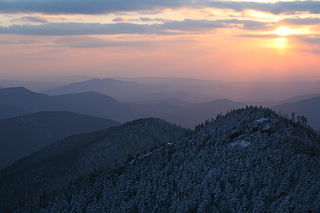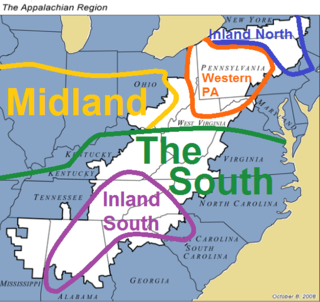
Appalachia is a geographic region located in the central and southern sections of the Appalachian Mountains of the eastern United States. It stretches from the western Catskill Mountains of New York state into Pennsylvania, continuing on through the Blue Ridge Mountains and Great Smoky Mountains into northern Georgia, Alabama, and Mississippi. In 2021, the region was home to an estimated 26.3 million people, of whom roughly 80% were white.

The Great Smoky Mountains are a mountain range rising along the Tennessee–North Carolina border in the southeastern United States. They are a subrange of the Appalachian Mountains and form part of the Blue Ridge Physiographic Province. The range is sometimes called the Smoky Mountains, and the name is commonly shortened to the Smokies. The Smokies are best known as the home of the Great Smoky Mountains National Park, which protects most of the range. The park was established in 1934 and, with over 11 million visits per year, is the most visited national park in the United States.

Appalachian English is American English native to the Appalachian mountain region of the Eastern United States. Historically, the term Appalachian dialect refers to a local English variety of southern Appalachia, also known as Smoky Mountain English or Southern Mountain English in American linguistics. This variety is both influential upon and influenced by the Southern U.S. regional dialect, which has become predominant in central and southern Appalachia today, while a Western Pennsylvania regional dialect has become predominant in northern Appalachia, according to the 2006 Atlas of North American English (ANAE). The ANAE identifies the "Inland South,” a dialect sub-region in which the Southern U.S. dialect's defining vowel shift is the most developed, as centering squarely in southern Appalachia: namely, the cities of Knoxville and Chattanooga, Tennessee; Birmingham and Huntsville, Alabama; and Asheville, North Carolina. All Appalachian English is rhotic and characterized by distinct phonology, morphology, syntax, and lexicon. It is mostly oral but its features are also sometimes represented in literary works.

The Appalachian Regional Commission (ARC) is a United States federal–state partnership that works with the people of Appalachia to create opportunities for self-sustaining economic development and improved quality of life. Congress established ARC to bring the region into socioeconomic parity with the rest of the nation.

Songcatcher is a 2000 drama film directed by Maggie Greenwald. It is about a musicologist researching and collecting Appalachian folk music in the mountains of western North Carolina. Although Songcatcher is a fictional film, it is loosely based on the work of Olive Dame Campbell, founder of the John C. Campbell Folk School in Brasstown, North Carolina, and that of the English folk song collector Cecil Sharp, portrayed at the end of the film as professor Cyrus Whittle. The film grossed $3 million in limited theatrical release in the United States, which was generally considered as a respectable result for an arthouse film release in 2001.

Appalachian music is the music of the region of Appalachia in the Eastern United States. Traditional Appalachian music is derived from various influences, including the ballads, hymns and fiddle music of the British Isles, and to a lesser extent the music of Continental Europe.

A folk healer is an unlicensed person who practices the art of healing using traditional practices, herbal remedies, and the power of suggestion. The term "folk" was traditionally associated with medical and healing practices that weren't explicitly approved by the dominant religious institution. If people didn't seek healing from an approved priest or religious figure, they would seek the help of the local folk healer. Folk healers, despite their technical illegitimacy, were often viewed as being more involved with the healing process and made their patients more comfortable than other practitioners. With modern medicine being preferred, some look towards folk healers to get consoled from the sacred use of traditional medicine. "Appalachian folk healing goes by many names, depending on where it’s practiced in the region and who’s doing the practicing: root work, folk medicine, folk magic, kitchen witchery."

The Museum of Appalachia, located in Norris, Tennessee, 20 miles (32 km) north of Knoxville, is a living history museum that interprets the pioneer and early 20th-century period of the Southern Appalachian region of the United States. Recently named an Affiliate of the Smithsonian Institution, the museum is a collection of more than 30 historic buildings rescued from neglect and decay and gathered onto 63 acres (25 ha) of picturesque pastures and fields. The museum also preserves and displays thousands of authentic relics, maintains one of the nation's largest folk art collections, and hosts performances of traditional Appalachian music and annual demonstrations by hundreds of regional craftsmen.
The Encyclopedia of Appalachia is the first encyclopedia dedicated to the region, people, culture, history, and geography of Appalachia. The Region, as defined by the Appalachian Regional Commission, is a 205,000-square-mile area that follows the spine of the Appalachian Mountains from southern New York to northern Mississippi. It includes all of West Virginia and parts of 12 other states: Alabama, Georgia, Kentucky, Maryland, Mississippi, New York, North Carolina, Ohio, Pennsylvania, South Carolina, Tennessee, and Virginia. Forty-two percent of this Region's population is rural, compared with 20 percent of the national population, but the region also includes urban areas, such as Pittsburgh and Chattanooga. The encyclopedia is 1,832 pages long and contains over 2,000 entries. Produced by the Center of Excellence for Appalachian Studies and Services at East Tennessee State University (ETSU), Rudy Abramson and Dr. Jean Haskell, are the two main editors of the encyclopedia. Jill Oxendine served as managing editor. The volume was published in March 2006 by the University of Tennessee Press. It includes a foreword by William Ferris, former chair of the National Endowment for the Humanities, who called the encyclopedia "truly a feast of information about its region. .. a remarkably detailed portrait of a landscape that runs from New York to Mississippi.” The volume also includes an appreciation by Henry Louis Gates Jr., Alphonse Fletcher University Professor and Director of the Hutchins Center for African and African American Research at Harvard University, who is a native of West Virginia. Gates wrote that the encyclopedia "lays out for everyone else what we who grew up there have always known. Appalachia is a rich and beautiful land steeped in tradition and open to change. It is home to countless storytellers and stories without end. Both its lushness and its rockiness teach us to make our way in the world, but Appalachia never leaves us."
Wilma Dykeman Stokely was an American writer of fiction and nonfiction whose works chronicled the people and land of Appalachia.

Appalachian studies is the area studies field concerned with the Appalachian region of the United States.

In the Appalachian Mountains of the eastern United States, balds are mountain summits or crests covered primarily by thick vegetation of native grasses or shrubs occurring in areas where heavy forest growth would be expected.
Settlement schools are social reform institutions established in rural Appalachia in the early 20th century with the purpose of educating mountain children and improving their isolated rural communities.
Our Southern Highlanders: A Narrative of Adventure in the Southern Appalachians and a Study of Life Among the Mountaineers is a book written by American author Horace Kephart (1862–1931), first published in 1913 and revised in 1922. Inspired by the years Kephart spent among the inhabitants of the remote Hazel Creek region of the Great Smoky Mountains, the book provides one of the earliest realistic portrayals of life in the rural Appalachian Mountains and one of the first serious analyses of Appalachian culture. While modern historians and writers have criticized Our Southern Highlanders for focusing too much on sensationalistic aspects of mountain culture, the book was an important departure from the previous century's local color writings and their negative distortions of mountain people.
Emma Bell Miles was a writer, poet, and artist. Her works capture the essence of the natural world and the culture of southern Appalachia.
W.K. McNeil was a prominent American folklorist, historian, record producer, and author specializing in Ozark and Appalachian mountain cultures.
Claude Howard Dorgan was an American academic best known for his research and writing on the topic of religion in Appalachia.
Jim Wayne Miller was an American poet and educator who had a major influence on literature in the Appalachian region.
Barbara Ellen Smith is an American author, activist, and educator. She is known for her involvement and writing about social justice in Appalachia, particularly the Black Lung Movement and advocacy for coal miners. Smith sustains her career of more than 40 years by continuing to make contributions in the intersecting disciplines of women's and gender studies, sociology, geography, and Appalachian studies as a professor and author.
Michael Ann Williams is an American Folklorist, recognised for her research into vernacular architecture, particularly in Appalachia.










